We all know there are some great, classic electric guitars out there… but which ones can be truly deemed “perfect guitars”? Well, this Top 10 list may just have the answer!
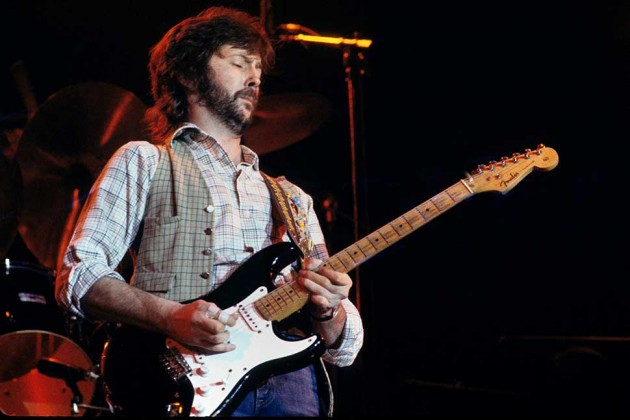
Eric Clapton Live… with his trustworthy Strat!
Hi everyone I hope you have been enjoying my column, here’s more stuff to ponder. It seems every time you turn around there’s another list, 100 best this, 10 worst that’s. Well here’s another list for ya! But at least this one does not involve Paris Hilton. I now that some of my listings may be a bit controversial (one in particular) as I said before these are my opinions based on my experiences. Like all things in music they are not right or wrong, just some good-natured opinions that will hopefully stimulate your own thoughts on this subject.
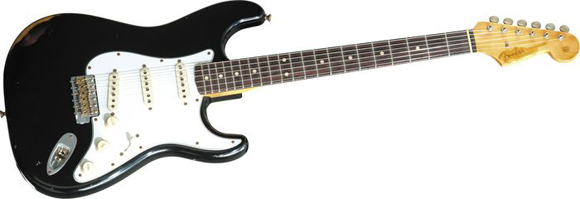
Fender Stratocaster Electric Guitar
#1 Fender Stratocaster: The guitar that defined rock and roll music.
This guitar is as crucial a design and tool as can be expressed. It is unparalleled in it’s uniqueness and sound. Nothing sounds like a Strat, the bridge pickup sounds similar but not the same as a Tele bridge pickup. The same can be said for the neck pickup, and the middle pickup is so unique I cannot think of another guitar sound that can be mistaken for it. And the “between the pickups” sound is what it is truly Strat-esque. Leo was a god among men.
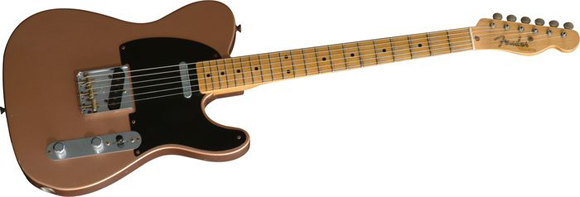
Fender Telecaster Electric Guitar
#2 Fender Telecaster: The most versatile guitar ever made.
The Telecaster, Leo Fender’s maiden voyage into the uncharted world of guitardom. The only guitar that can be credibly used as a rock, blues, country and yes, jazz guitar (even with the stock single coil in the neck position). The best way I describe the Tele when asked why it is my favorite guitar is that my ideas on the Tele are mostly musical ideas not sonic ideas (like the Strat). The Telecaster don’t play itself brother, it’s all there for the taking, but you must be man enough to take it. It’s low maintenance and very consistent from Tele to Tele.
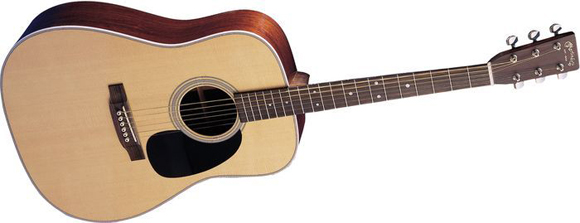
Martin D-28 Dreadnought Acoustic Guitar
#3 Martin D-28: The standard of what an acoustic guitar should sound like.
I dunno I guess I must have been a real jerk when I was young, because I thought Martins were overrated and inconsistent. I was so brainwashed that one day I went into a guitar shop in New York with the sole intention of buying a J-200. While I was there the proprietor said I must check out this Martin D-28, and I did. Let me tell you this guitar was a dream come true, it came alive when you strummed a chord. The top vibrated so strongly I checked to see if it was cracked. It sounded even and true, it sounded so good that I thought to myself “I ain’t good enough to play this guitar.” So I bought the J-200 with the fancy clouds on the fretboard that sounded like a surfboard. BTW I recently contacted the guy who bought that J-200 and it still sounds like a surfboard 20 years later. The D-28 works for all kinds of music, bluegrass, rock and even blues as it is a very underestimated slide guitar ( not many of us have the scratch to play a 28 for slide only though).
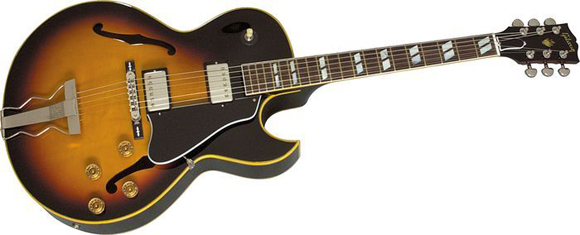
Gibson ES-175 Electric Guitar
#4 Gibson ES 175: The best amplified arch top.
I am sure Joe Pass could have played an L5 if he wanted to, and after playing the ES 175 live I understood why many jazz guitar players chose the mid line maple top box. I have found them to be consistent and manageable at higher volumes or when you are set up close to your amp. I also own a Gibson Tal Farlow and have found it to be an ornate version of the 175. I also like the Lawsuit Ibanez 175 copies very much if you don,t mind the narrow neck profile.
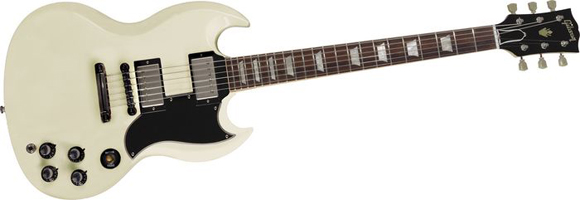
Gibson SG Electric Guitar
#5 Gibson SG: The ultimate rock and roll guitar.
Short and sweet here. It’s easy to play, it’s light, it looks amazing, it cuts through like no other humbucking guitar on the planet, and it sounds good with virtually any decent amplifier. Here we go, Young, Iommi, Zappa, Clapton, Harrison, Santana (early w/ P90’s), Townsend (also P90’s). Great lead guitar, awesome rhythm guitar. SG Suggestion: Try a hi-output Humbucker in the bridge position like a DiMarzio Super Distortion it will amaze you; it will still cut like a knife.
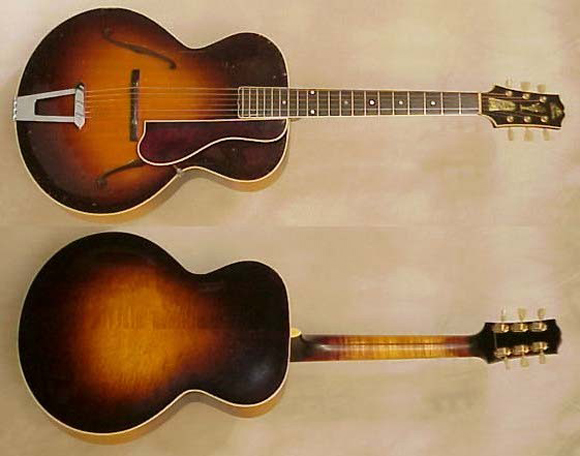
Gibson L5 Archtop Guitar
#6 Gibson L5: The standard for what an acoustic arch top is.
I am speaking strictly about the acoustic L5 model only. This is the model that greats like Freddie Green played so well in the big band setting. A little background on the non amplified arch top, I always felt that the guitar player in early big bands served as a chord voice in the rhythm section just as the banjo player did in the New Orleans jazz bands in the early 20th century. They kept the rhythm for the musicians and were barely heard by the audience. Just say it, Gibson L5. Ahhh!
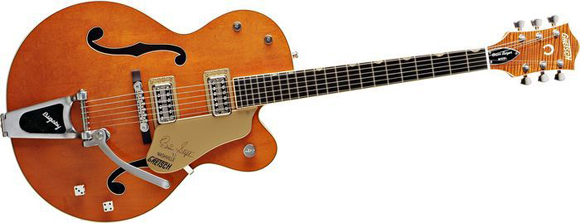
Gretsch 6120 Electric Guitar
#7 Gretsch 6120: Eddie Cochran and Chet Atkins, what else needs sayin?
The match of a visionary guitar player and a Gretsch 6120 seems to very common in guitar lore. This guitar has an arch top design, that combined with the Bigsby tremolo and the Filtron pickups give this guitar a sound that is rockabilly yet with a tweak of the tone controls can be tamed into a great accompaniment guitar as well. I always felt that the sound from this Gretsch was somewhere between an ES series Gibson and a Telecaster (not a bad neighborhood). My experience also tells me that the 6120 sounds damn good plugged into almost any amp I ever heard it with. One of my faves was my 6120 plugged into a Lab Series L5 amp housing a 15 inch JBL E130 speaker. This guitar is great for rockabilly, country, surf, chordal rock rhythm guitar, and any ensemble music.
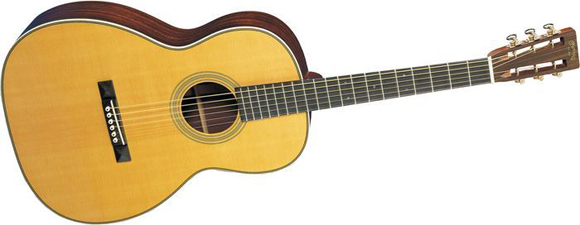
Martin 000-28 Acoustic Guitar
#8 Martin 000-28: The ultimate blues and finger style acoustic guitar.
Also the OM-35 the long scale version of the 000 body size. I know this might be a somewhat controversial choice but, this comes from my own playing experience as well. I always marveled how the great bluesman would manhandle the guitars they played, in lieu of the fact that many of them had these enormous hands. I always felt that the mass of these hands in comparison to the at most times low budget guitars they played led to the sound they produced. This particular mortal (me!) who did not sharecrop or toil as many of these great men had to do just can’t seem to be able to get that sound from a dreadnought, but when I play a 000 size guitar I feel like Big Bill (Broonzy) himself. I can fingerpick with ease and muffle and mute just like Lightning Hopkins. The even sound of the 000 also lends itself to the unaccompanied nature of solo blues guitar. You may ask “why have I not seen some of these great bluesman play a 00-28?” My answer to that question is two-fold I believe economics is one, and the fact that many of our legendary bles pickers preferred more ornate guitars, and stayed away from the “country guitars.” The Martin 000-28 is a true classic!
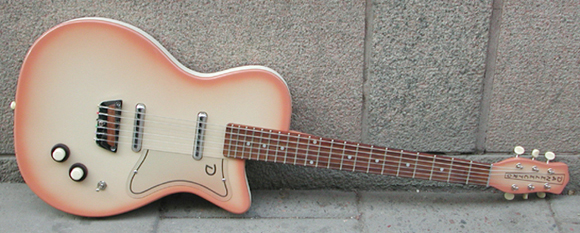
Danelectro Solid Body Guitar
#9 Danelectro solid body: The best cheap guitar ever made.
As far a the Danny is concerned, I ask you will it compete with the Les Paul or Strat as your primary guitar? Obviously not, but I ask you is there a more versatile/ quality “off the wall” guitar. It’s an unreal slide guitar (see Lindley in your guitar dictionary). A great rootsy rhythm or lead guitar, and how many of the great Chicago bluesman have you seen playing these guitars? They cut through very well when played alongside other guitars. And the shielding and pickups were very ahead of their times. They look god awful cool, they stay in tune when set up decently. And again I will say that I have never heard a Danny not sound like a Danny through any amp, actually the cheaper the amp the better they sound. I actually prefer the two pickup model for slide and the three pickup for regular application. The twelve strings and odd ball models like the sitar and bellzouki and Guitarlin also sound awesome. The reissues are as good as the originals, and actually play better, although I like the sound of the old pickups better. Go out and buy a half dozen of them right now!!!
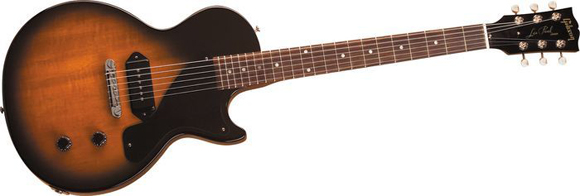
Gibson Les Paul Jr Electric Guitar
#10 Gibson Les Paul Junior: Turn it up and bang away a no frills no brainer.
The name “Junior” almost demeans the stature of this guitar. When I say perfect I mean that perfect for the application it is used for. Ask anyone who has ever owned one they all say the same thing – “I should have never got rid of that Jr.”; I am also including all the Les Paul Junior variants as well as the early SG Jr.s as they all serve the same purpose to me. I have always felt that when guitar god Leslie West played his Junior his technique was so strong that it compressed the sound like he was squeezing a golf ball through a garden hose. The guitar reacted so well to his hands, there had to be a reason Leslie played the Junior for so long. First of all has anybody ever heard a bad sounding ones? The only difference I have heard was that I prefer the fatter neck Jr.s as they seen more stable and have a bit mote chunk and sustain. These guitars sound great coming through any amp, although they obviously do not sound as good through a solid state amp. I sometimes wish that I could play my Jr.s more often, but my particular style demands a bit of a more versatile guitar. Yes, the Jr. is not a very versatile guitar, but its still perfect as far as what it does, and what it does is kicks ass!
The Best Of The Rest…
These guitars are great, but not perfect. Let’s say… they are a respectable 9 out of 10!
Les Paul model
Too inconsistent, too many variables great ones are great, bad ones suck. Some are way too heavy, I have seen Les Pauls that weighed in excess if 12 lbs, that’s too much and way too inconsistent. I have always believed from the over 30 years of guitar worship that the Les Paul was the red headed stepchild at Gibson and did not get the attention it deserved. Here’s a hint or two on picking a good Paul – from me to you: #1 if the neck pickup has a high endy squawky “cut” you are well on your way. #2 if it could replace a Tele in a pinch it’s a winner in my book. Muddy, low mid laden Pauls give the model a bad name.
Mosrite Ventures
Great look and design, great sound but, Too thin neck and too small frets, bad tremolo (arm too short and too close to the body and gets “mushy” fast, Not great woods that many times don’t match in weight and density. For a more modern take on the design, make sure to check the Eastwood Sidejack series, which is getting even more popular than the originals!
Gibson ES-335
Some with necks that are unplayably thin. Bridge pickups are not trebly enough (not pickups themselves I believe it’s a design flaw). Great blues guitar in the right hands. A one trick pony.
Gibson ES-345 and 355
The Varitone need I say more? I own several of them but they cannot be my only guitar at a gig.
Gibson L5 CES
Too much pickup for a spruce top arch top. The guitar explodes out of your hand when played proximate to an amp, Useless treble pickup. Yeah I know Wes Montgomery played one (his was a one pickup model), well lets not compare ourselves to Wes okay? I also heard from a reliable source that Wes altered his guitars so they wouldn’t feedback, and that his left hand technique restricted this problem also.
Gibson acoustics: J-200/ J45/J160
Inconsistent, too long to break in, by the time you know whether you have a good one or not you are ready to retire. Buy a used one that sounds good and be happy you got a good one.
Rickenbacker V64 12-string
Aside from the string spacing being too close this is a perfect 12 string electric, but not perfect. Check out the Carl Wilson model if you can find one. George, how did you do it?

I would love to be able to purchase the guitar I admired in the music store. (Frank Ralph’s music) Gansett avenue Cranston Rhode Island 02920. I was 8 years old. And he had it in the window with a couple of others. They said ‘DOMINO’ on them. It was 5 sided. It was my dream. Since that time I have done most everything in the music business except find and purchase this particular guitar. In fact, I was absolutely convinced that NO person in the world ever even heard of these guitars. Well. There is a picture of it on a site called myvintageguitars.com. Where can i find and buy this guitar? 43 years have gone by ad i have NEVER forgotten it. I have talked about it many many times over the years to all my musical contacts. I would always say, “I’m going to run across this particular guitar someday before I die, and own it.” Maybe even be blessed enough to play a few gigs with it. Is there any way you can help me. I would be so grateful. It’s the five sided white with wood grain pickguard center if you will, and it says ‘DOMINO’ on the headstock. What do i have to do to get one of these?. I will do almost anything!. Am I correct in saying I think I remember a see thru one also? I look so forward to hearing back from you. Maybe even with some good news – like you know where i can buy one. My name is Dave Olszewski originally from Rhode Island. I now reside in Florida. I’m not getting any younger, is there a CHANCE I will ever have my dream guitar/…the one wanted since i was 8 years old/. Please let me know. Sincerely, David M Olszewski manonemusic@netzero.net
Well as you said it’s your opinion, but let ME tell you something. You’re not bad informed, but the les paul models (especially the dearmond m75 and 75t) are one in a million guitars. It’s heavy, I know, but you must have balls to carry it. If you want to sound great you must go by NO PAIN NO GAIN. That’s all. Thanks anyways.
The Gibson 175 may have been the bees’ knees in its day (although I would take a Guild over a Gibson any day — far more consistent quality) but the stunning quality of Korean and Japanese makers such as Peerless, Samick, (and the splendid jazz instruments Samick make for Hohner) Edwards, Yamaha, Ibanez, Tokai etc leaves poor old Gibson looking like the Chrysler of the guitar world — stodgy, overpriced and unreliable.
Great list and I concur. Some other unmentioned perfect guitars for specific unmentioned applications:
Harmony H62/Silvertone Espanada/Harmony H44 – Swing & Jump Blues
Danelectro Baritone – Blues, Country, Surf, Spaghetti Western, Studio. Also, the Danelectro shown is actually a hollow body which adds to it’s acoustic resonance. The Danelectro U2 and the 1963 Reissue and the DC are all hollow. I own them and like the author said, they are great guitars. I use them for all applications in blues specifically, they are great for slide. A quick demo of me playing slide on my 1963 Danelectro Reissue through a 1973 Musicmaster Bass Amp, no effects:
http://www.youtube.com/watch?v=DD6l5-88cLQ
Thanks for the cool articles and guitars! Just bought a Harmony H62 Artist Reissue with P13s. Very nice guitar!
Freddie Green played guitars by Epiphone, Gretsch, and Stromberg, but never an L5 to my knowledge.
i have 20 guitars but mostly play only two my strat and my eastwood joey leone i love both of these guitars they have many usable tones but the eastwood is just a step or two above just a beautiful guitar
The image of 000-28 is not correct. It is a 000-28VS. Check these:
http://www.martinguitar.com/model/item/209-000-28.html
http://www.martinguitar.com/model/item/70-000-28vs.html
Easily; the best summation (w/o using Paris Hilton) of the top 10 guitars and their respective application. The author simply gets it from his defining the Tele as, “it’s all there for the taking” down to the LP jr’s rating higher then it’s big brother due to it’s (LP Standard) infamously earned “Muddy, low mid laden” issues. It is also worth noting that all of the guitars mentioned as “Perfect” (let alone the ones ranking 9 out of 10), have been available on the retail market for the best part of 50 years!!! GREAT article!
Your Martin D-28 story resonates with me, if you’ll forgive the musical analogy.
It was about 1970 when I took my guitar in to a shop to have the guy do whatever it is they do in there to make a mediocre guitar sound a bit better. The owner of the shop took my guitar and asked if I would be interested in looking at a Martin D-12 28.
I said sure, but I can’t possibly afford it. He said it was on consignment from some guy who was being sent to Viet Nam and needed fast cash. No way, thought I. Then I strummed it once. My whole world changed in that instance.
I HAD to have it. It took me my old guitar plus 2 weeks of my salary, but I got it. I’ve had it ever since. I take it to a guitar store now to be strung (hate stringing a 12 string myself). He says it’s the most beautiful sounding, easiest play guitar he’s ever touched.
My baby is now 46 years old.
Hi, I agree with your overview, yet as somebody who plays since 1958 (and has owned most of your top ten guitars) I now adore Gibson Les Pauls. The 2013 standard and/or traditional plus and/or 1994 Studio can sound fine. I adore to buy a good studio and replace pickups with Bare Knuckles models 🙂 Note that some Godin guitars are great, as they use good materials and ebony … Thanks, Davor
Where is the workhorse? The Gibson J45! It’s best guitar I ever owned and stays in tune.
A Tal Farlow is NOT simply an ornate version of the 175 that is very misleading…
While the 175 has more lower end because of the thickness, it has a looser bass tone because of the 24.75 scale. The Tal Farlow has a 25.5 scale and is way more mid focussed making it also more percussive in tone. It cuts better through a mix and I wonder they are not used more.They are in my book the hidden gem of the Gibson Archtop and the best value. New they are very expensive but used you can find them for a steal while everyone are into 175…
What model is the danelectro?
Dear Manager,
Glad to learn you’re on the market of musical instruments.
230 workers, 15000 ㎡ non-dust workshop, 12 years experience, 3 years’ vendor of Wal-mart, Gewa Germany, ROHS, CE certificated, half hour reach Shenzhen port, this is how we keep superior quality and competitive offers for global valued customers.
Our main products cover tube guitar amp, hand wired amp, amp kits, custom guitar series.
If any product meed your demand, please contact us for further information.
We’re sure your any inquiry or requirement will get prompt attention.
Best regards,
Bella
http://www.bestamp-guitar.com
http://www.bestgrand-music.com
I have had quite a few good guitars and all 2nd hand and one new fender stratocaster in the 80’s sold every thing and now wish i still had them all .dont part with what good , you cant replace them once there gone. Whats wrong with makers today some are so poorly made there not even fit to be call a guitar. Maybe some one will combine a number of designs in to one, a les paul with a fender neck we one likes to experiment even a fender tremalo added on and vis versa. Would be an interesting experiment
hard to believe your list did not include the PRS Mc Carty or the modern eagle …….. amazing guitars that just feel so good you never wanna stop playing them …… I know they cost a ton like most of the stuff paul makes but I feel in todays world any list of the best has to include a PRS model ….. thank you and would appreciate any feedback from any of the players and collectors
Enjoyable reading and useful.
I own a D28 and it has a unique sound that I love. Comes with ‘medium’ guage strings which takes some strength at first. In a different way, I love my $300 Corte solid top dreadnought inclusive of Fishman pickups. (and a Corte strat copy with up-market pickups.). One has to test a number of guitars and find one with a good neck (for a start) and the tone that suits. Heavy strings versus light etc.
I have a jay turser hollow body and a 56 fender strat but my favorite is the lotus telecaster I got from a pawn shop years ago. I can get any sound I want and the action is incredible